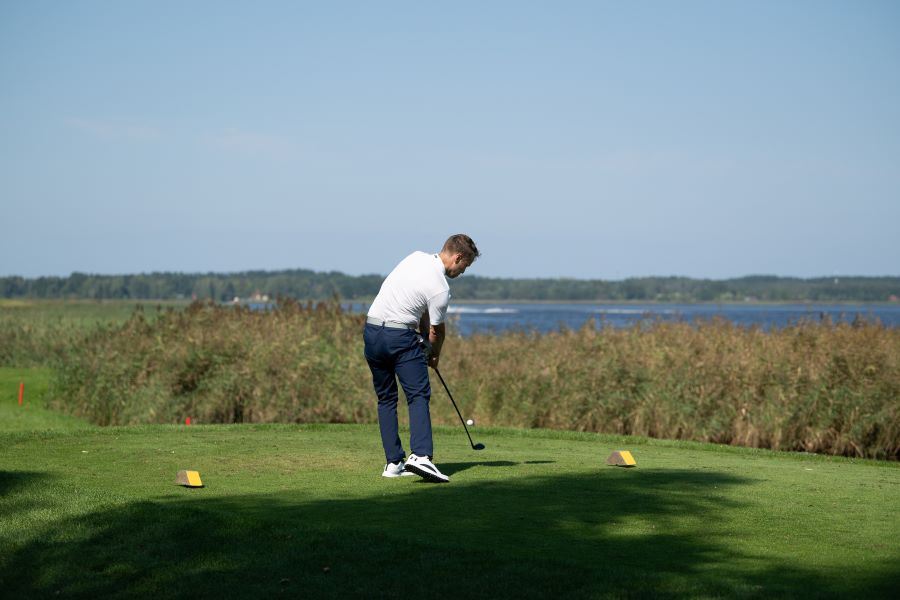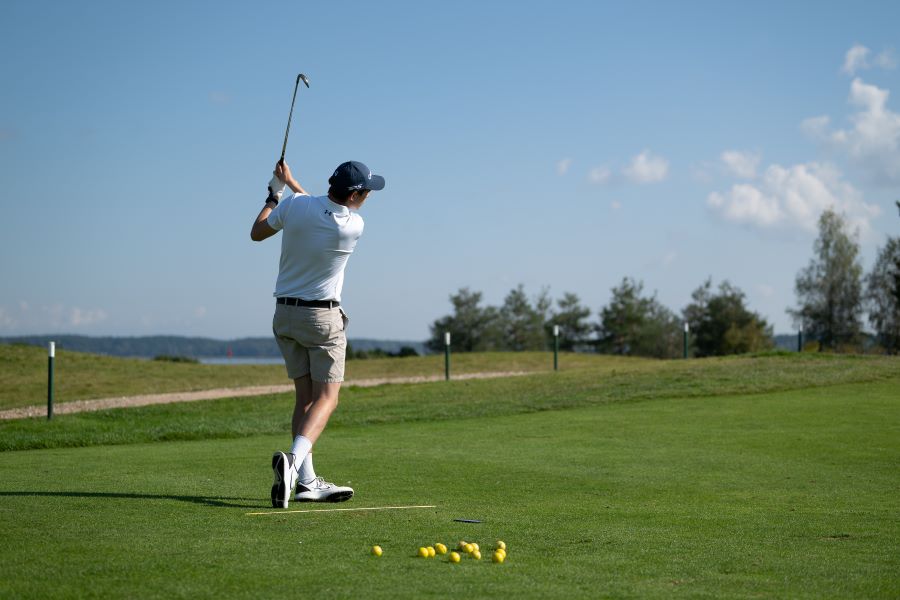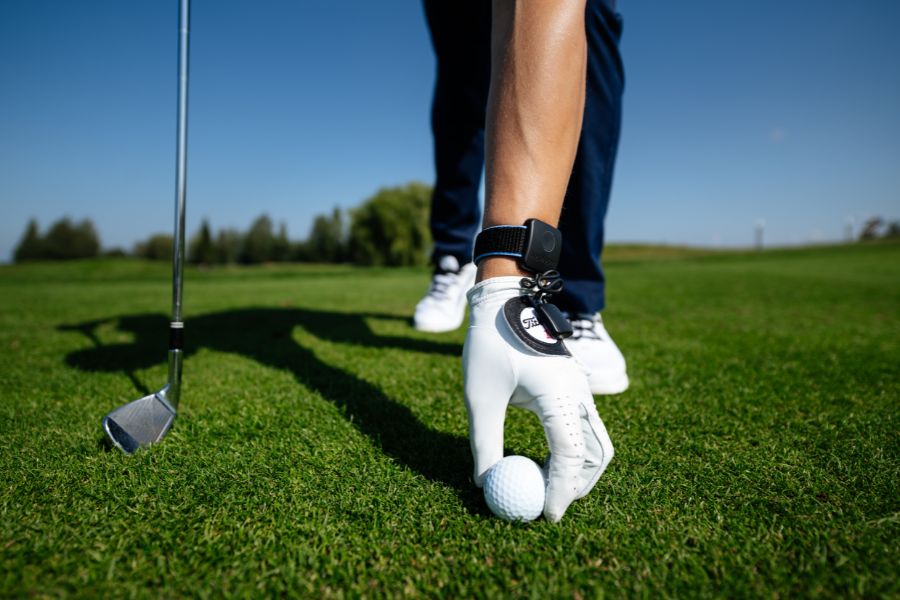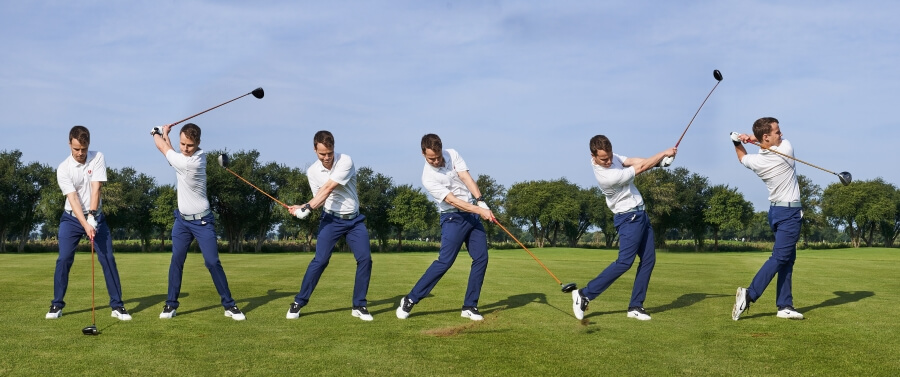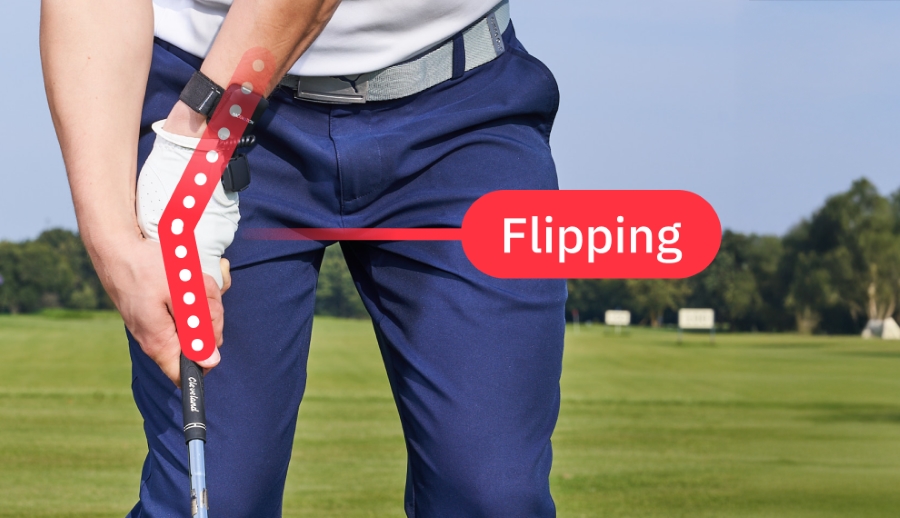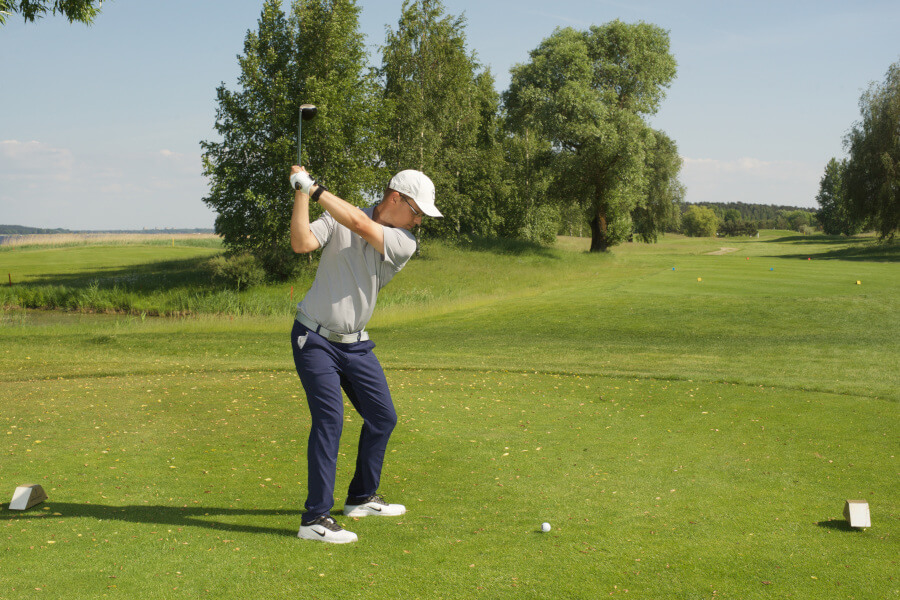Slice vs Hook – What’s The Difference, Main Causes & How to Fix Them
While the slice may be the most common miss that golfers struggle with, the hook is not too far behind.
A slice and a hook are both considered more extreme misses (different than a draw or a fade) that put you in trouble, cost strokes, and make it difficult to be confident at impact.
Your clubface angle at impact (controlled by your lead wrist position) is what creates the slice or hook ball flight.
We will show you all the differences between a slice and a hook and what you need to work on to fix them.
Key Takeaways
If you need a quick recap on the differences between the slice and the hook, here is everything you need. Read the entire article to get more detailed drills and information to help you fix either mistake.
- Slice (Right Handed golfer) = ball starts left, curves hard right. Face is open to the swing path.
- Hook (Right Handed golfer) = ball starts right, curves hard left. Face is closed to the swing path.
- Face-to-path is everything. According to the modern Ball-Flight Laws, the clubface sets the ball’s start-line; the path (relative to that face) adds the curve.
- Typical slice triggers: weak grip, lead-wrist extension (“cupped”), open shoulders/ball too far forward, out-to-in path.
- Typical hook triggers: strong grip, lead-wrist over-flexion (“bowed”), early extension or “flip” release, in-to-out path.
Fixes: change the wrist first (use HackMotion to show wrist position in real-time), then match grip, setup, and release to that new wrist position.
Contents
Slice vs Hook: What’s the Difference?
Remember that the slice vs. hook will be different for left-handed and right-handed golfers.
The descriptions below are for right-handed players; left-handed golfers can reverse this.
- Slice: For a right-handed player, the ball launches left of the target line, then peels off to the right. The face is open to the path.
- Hook: The mirror image. Ball launches right, dives left. The face is closed to the path.
Both shots cost distance and leave you having to hit a recovery shot.
Causes of Slice vs. Hook
Before we dive into the drills for fixing the slice and the hook, let’s break down the causes and why you may struggle with one.
Grip
- Weak grip = Slice. If you see one (or zero) knuckles on the lead hand, the wrist sits almost flat at address. You’ve given yourself a huge range of motion to open the face during the swing. The trail hand also does not have enough control to help you square the face.
- Strong grip = Hook. Three-plus knuckles and a trail hand overpowering the swing can add too much flexion in the lead wrist. The face wants to close, and you’ll instinctively swing more from the inside to start the ball on-line.
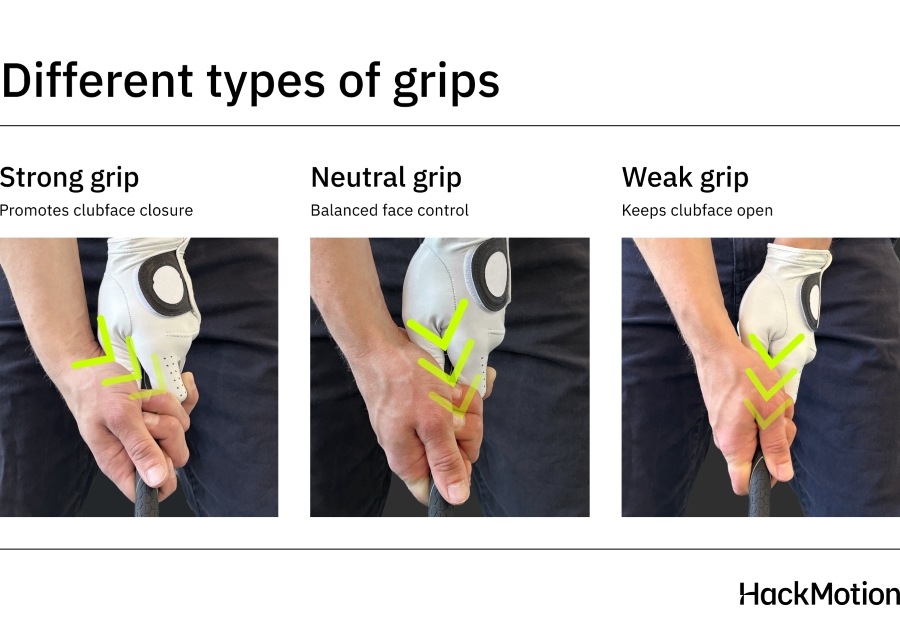
Lead-Wrist Position
The position of the lead wrist controls the clubface. If your lead wrist position is not flat at the top and slightly flexed at impact, you can hit either a slice or a hook.
- Extension (cupped) will cause slices. HackMotion numbers jump positively (+°) when the wrist arches. In transition, slicers usually add extension, throwing the face wide open.
- Flexion (bowed) will create hooks. Negative (-°) readings close the face. Too much, too early, and the ball has nowhere to go but left. While having some bowing through impact can be a positive, it has to be timed correctly and not too extreme.
Alignment & Ball Position
Slicers tend to have their shoulders open and the ball too far forward.
This setup position creates more of an out-to-in path, and if you combine that with an open clubface, you’ll end up with a slice.
The golfers who hook typically have closed shoulders and a ball too far back in the stance. This leads to an exaggerated in to out path.
The in to out path with a shut face will send your golf shot well left of the target.
This is what your ideal ball positions should look like, and you should learn to tailor your swing to those ball postions.
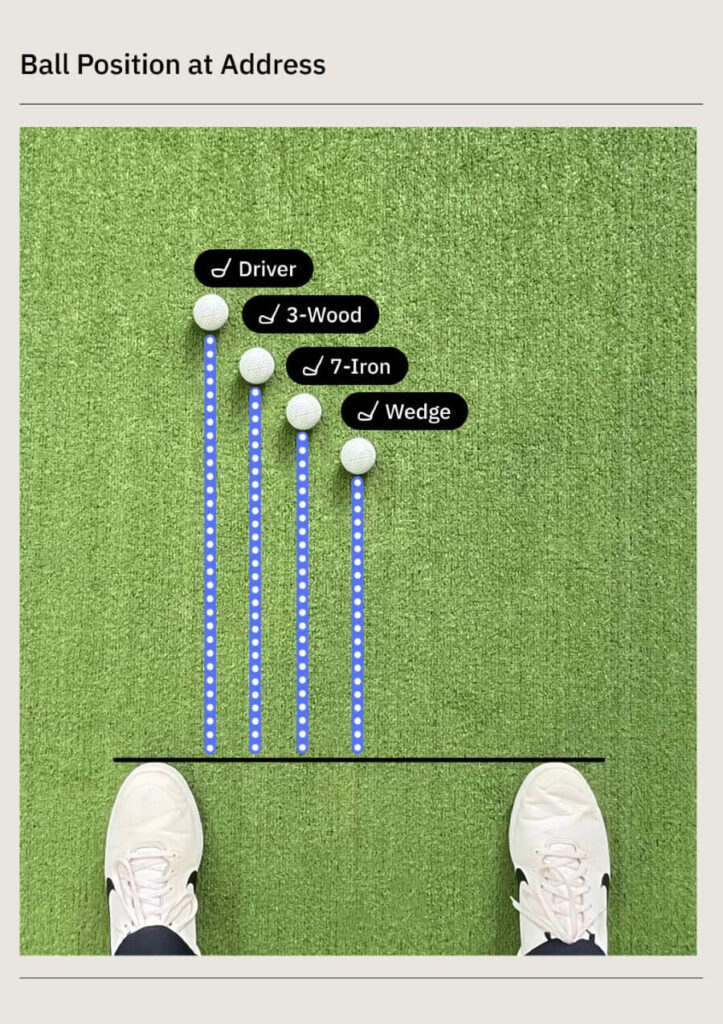
Posture & Early Extension
If your weight is back in the heels as you swing back, on the way down you’ll have nowhere to go but forward and to cut across the golf ball.
This is where a slice comes into play. For players who are more hunched and tend to stand up early the hips can thrust toward the ball, the arms get trapped, and to save the shot, you may hook it.
Below is what a proper setup position should look like, with your center of mass balanced over the middle of your feet.
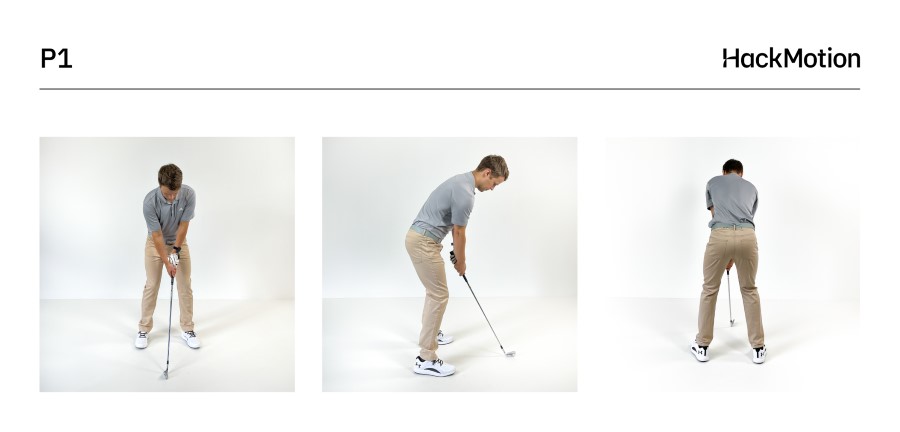
The bottom line here is that your setup position can cause a hook if you aren’t careful.
Release Pattern
On the downswing, you’ll have to pay close attention to the release to hit a straight shot. Golfers who do not pronate (the trail forearm never rolls over) will leave the face open at impact.
Golfers who overpronate or flip tend to slam the clubface shut, deloft the club, and hit a duck hook.
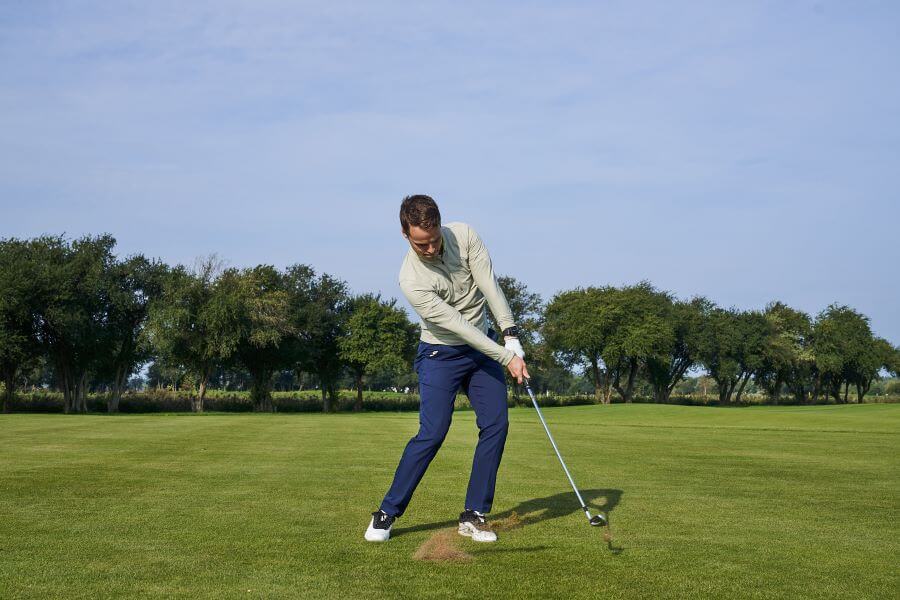
How to Stop Slicing
Now that we know all of the negative (the causes and the results), let’s look at the ways to actually fix these mistakes.
We’ve given you a few drills to fix a slice and finally learn to square that clubface.
While you can use your HackMotion to get real-time feedback and data for these drills, you can also do the drills without.
Forward-Up Handle Setup
This is a simple drill that is more of a setup adjustment than anything else. Golfers tend to have their hands in a poor position to start with the handle of the club too low and behind the hands.
In the video below Rob Cheney will show you how to fix it:
- Video timestamp – 6:10
Forward Handle Setup – Step by Step:
- Set Up: Take your normal stance, then push the handle a fist-width forward and slightly upward.
- Check Grip Position: The grip cap should hover near your belt buckle—this helps flatten the lead wrist naturally.
- Swing: Make slow half swings to start. Focus on keeping the wrist stable throughout.
- HackMotion Feedback: If the reading is around –10° at address and stays in the negative range to the top, you’re set up for success.
Transition Flex Check – Motorcycle Drill
As a slicer, your clubface is likely open at the top of your backswing.
As you start the downswing, you want to focus on moving that clubface position from open to square or even slightly closed.
The idea is to feel that motion of revving the motorcycle throttle in your lead wrist on the downswing.
Try this drill located in the HackMotion app to measure your results in real time.
Motorcycle Drill – Master Wrist Flexion in the Downswing
Focus on continuously adding flexion until the club reaches parallel, then smoothly complete your swing.
Motorcycle Drill – Step by Step:
- Swing to the Top: Make a full backswing and pause at the top.
- Check Wrist Position: Observe your lead wrist and see if it’s in the ideal range (flat or slightly flexed).
- Add Flexion: Rehearse adding more flexion from the top—feel like you’re revving a motorcycle as you start the downswing.
- Repetition: Do multiple slow reps with this feel before progressing to hitting golf balls while maintaining that wrist action.
Hit Hard, Stop Quick
The Hit Hard Stop Quick drill teaches face control through impact.
This drill not only helps fix a slice but it can also help you add power to your swing.
- Video timestamp – 3:13
Hit Hard, Stop Quick Drill – Step by Step:
- Setup: Address the ball with your normal stance and posture.
- Small Swings: Make small half-swings and focus on accelerating through the ball.
- Stop Quickly: Stop the club just after impact, before it reaches shoulder height.
- Feel Structure: At the stop point, feel your hands ahead of the clubhead with forward shaft lean.
- Refine: Use HackMotion (optional) to check that your lead wrist maintains flexion beyond impact.
How to Stop Hooking
The good thing about a hook is that you know how to square the face; you are just doing it more than you need to or at the wrong time.
These drills help to neutralize the face and get your club on a better path.
Swing-Extender / Stick Under Trail Arm
If a last-second flip release is causing you to hook the alignment stick under the arm drill could be what you need to fix it.
- Video timestamp – 6:00
Alignment Stick Under the Arm Drill – Step by Step:
- Set Up: Tuck an alignment stick under your trail armpit so it rests against your ribcage.
- Start Small: Hit a few half-swing punch shots, keeping the stick in place throughout.
- Watch for Flip: If you flip your wrists at impact, the stick will hit your side—instant feedback.
- Correct Motion: If the stick stays clear until after impact, your shaft is leaning forward and your face is square.
- Progress: Gradually build up to full swings while maintaining proper structure and face control.
T-Peg Wrist Monitor
If your face is shutting in the downswing, some work with a simple golf tee could be the key to solving it.
- Video timestamp – 4:58
T-Peg Wrist Monitor – Step by Step:
- Set Up: Place a tee between the first two fingers of your trail hand so it sticks out like a pointer.
- Swing to P6: Make a backswing and stop when the shaft is parallel to the ground in the downswing.
- Check the Tee Direction: At this last parallel position, the tee should point at the target—not down or too far right.
- Use Video Feedback: Film your swing from the down-the-line view and check tee direction and wrist angle at P6.
Headcover Path Gate
If you are a golfer with a path that is too far in to out, the headcover path gate could be a good choice.
In fact, using this gate will help you with a variety of path related issues in the swing. Simply move the headcover to change what you are working on.
- Video timestamp – 7:00
Headcover Path Gate – Step by Step:
- Set the Gate: Place a headcover about 1 foot behind the ball and 1 foot inside the target line.
- Neutral Path Swings: Make swings that miss the headcover to avoid an excessively inside-out path.
- Watch Your Exit: Focus on swinging through the ball with a more neutral or slightly left exit (for right-handed golfers).
- Refine the Feel: Once you’re clearing the gate consistently, try small draws and fades to work on clubface control.
Final thoughts
You know your typical ball flight and whether the slice or the hook is hurting your game. Work on fixing the clubface first.
Using HackMotion to help fix your slice or hook is an effective strategy.
The best players can hit a slice or a hook on demand. If they run into a situation on the course where a slice or hook shot surprises them they already know what it takes to fix it.






